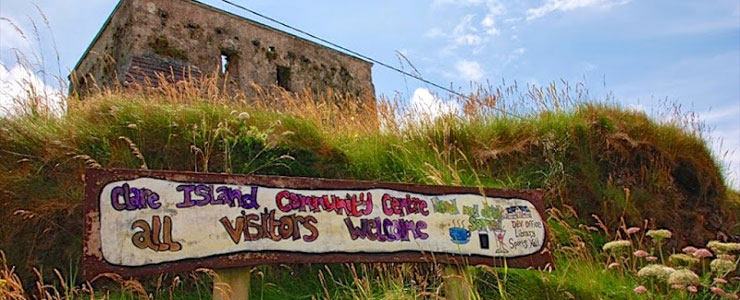To See and Do on Clare Island in Co. Mayo

Situated at the entrance to Clew Bay, Clare Island is the largest of the Mayo offshore islands. Located off the West Coast, Clare Island is 3.5 miles from the mainland and is also the largest of the possible 365 islands in Clew Bay - it is 5 miles long and 3 miles wide.
With its varied landscape of spectacular cliffs and inland mountain terrain, Clare Island is an ideal destination for hill-walkers and nature lovers who will enjoy exploring large colonies of sea birds, alpine flora and neolithic and bronze-age archaeology.
Boasting a rich topography of hills, bogs and woodland on the inner parts of the island, it is an ideal holiday destination for hill-walking, cycling and sight-seeing. The island is full of amazing scenery and visitors can explore it on foot, by bike (bike hire nearby) or by taxi.
The island has a number of B&B's, one hotel with a bar and one shop and post office. Clare Island is approx four miles off the nearest mainland point - Roonagh Pier (near Louisburgh) - the ferry crossing to the island takes 20 minutes. There is a frequent ferry service all year round with extra demand during the summer months when there is a steady tourist season.
SINGLES WEEKEND
Clare Island has an active community which hosts a number of festivals throughout the year including the well known “Singles Weekend”, which takes place annually in late September.
HISTORY & HERITAGE
Clare Island has an important cultural heritage including the ruins of a 14th century Cistercian Abbey containing important examples of Medieval wall-paintings, as well as a castle and burial place of the famous 'pirate queen' Grace O'Malley (Grainneuaile).
Although the summer sees an influx of visitors to the island, its normal population is less than 150, but everywhere there are traces of past generations. Old potato ridges, or 'lazy beds' as they are sometimes referred to, can be seen along the landscape.
These 'lazy beds' are historic evidence of the 19th century population explosion and subsequent famine when the island's population of 1600 was reduced by half.
In the early 1900s Clare Island was the subject of one of the most important natural history surveys in the British Isles - The Clare Island Survey, led by RL Praeger.
